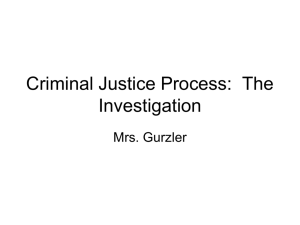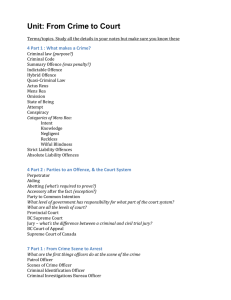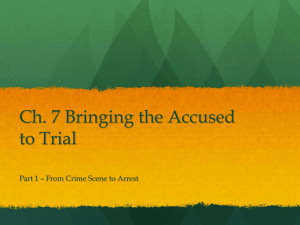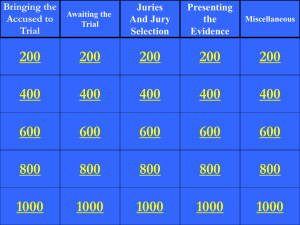CLU3M Investigation and Arrest
advertisement
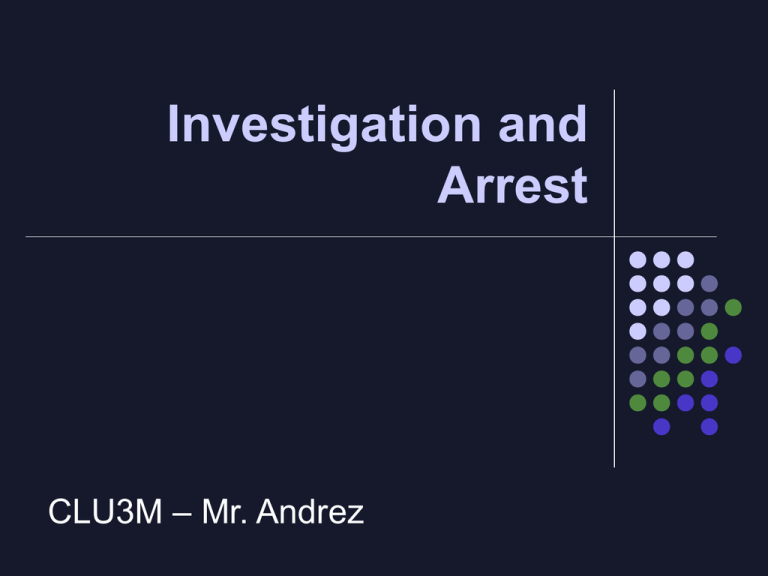
Investigation and Arrest CLU3M – Mr. Andrez Part 1 The Arrest Introduction Procedures for dealing with suspects are codified in the Criminal Code which has been developed through case law and enshrined in the Charter of Rights and Freedoms Arrest 1. 2. Must determine that an offense has been committed Must have reasonable grounds to believe that the suspect committed the offense 3 Choices 1. Issue an Appearance Notice 2. Arrest the suspect 3. Obtain a warrant for arrest 1. Appearance Notice Summary, hybrid and less serious indictable offences Names the offense the accused has been charged with Time and place of court appearance Accused must sign the document and receive a copy Officer will swear and information before a judge or justice of the peace States that the officer believes on reasonable grounds that the person named in the appearance notice committed the offence 2. Arresting the Suspect More serious indictable offences Suspect is arrested and taken into custody Arresting officer must Identify themselves Advise the accused that he or she is under arrest Inform the accused of the right to a lawyer (section 10(b) of the Charter) Inform the accused of the charges (section 10(a) of the Charter “everyone has the right on arrest or detention to be informed promptly of the reasons therefore.” Purpose of arrest 1. 2. 3. Lay charges Preserve evidence Prevent the accused form committing further offences Arresting without a warrant Section 495 of Criminal Code - Any officer can arrest without a warrant if there is 1. 2. 3. reasonable grounds to suspect a person has either committed an indictable offence or is about to commit one They find a person in the act of committing criminal offense They find a person whom they believe is named on an arrest warrant Section 495 applies to all “peace officers” (mayors, prison guards, customs officers, aircraft pilots, and fisheries officers Citizen’s arrest Shoplifting most common Suspect is arrested by a store detective or salesperson Immediately after a citizen’s arrest the suspect must be turned over to a peace officer Conditions for Citizen’s arrest – Section 494 CC The Arrest 1. Notice on arrest: I am arresting ________ for ________(reason for the arrest) 2. Right to council: It is my duty to inform you that you have the right to retain and instruct legal counsel without delay……Do you understand? 3. Caution to the charged person: You (are charged, will be charged) with ________. Do you wish to say anything in answer to the charge? You are not obligated to say anything unless you wish to do so, but whatever you say may be given in evidence…. Resisting arrest Police can use as much force as is necessary to prevent an escape Police are criminal liable for the use of unnecessary force 1. 2. 3. Maybe be necessary to use force causing bodily harm or death if it protects others from death of bodily harm 1994 – Parliament passed a law giving police the power to use deadly force – in the following situations: The behaviour of a suspect might cause serious harm or death to others The suspect flees to escape arrest There is no alternative means to prevent escape Advanced Taser Thomas A. Swift’s Electric Rifle CBC archives – Robert Dziekanski 3. Obtaining a warrant for an arrest Police ask judge to issue a summons (legal document issued for an indictable offence, ordering an accused to appear in court) When police believe suspect will appear in court voluntarily Delivered by a sheriff or deputy Suspect directed to police station for finger printing Failure to appear results in the issuing of a bench warrant (arrest warrant issued directly by a judge) 3. Obtaining a warrant for an arrest continued When police have reasonable grounds to believe the accused of a serious indictable offense will not appear in court willingly Obtain an arrest warrant Provide a sworn information (statement given under oath, informing the Court of the details of the arrest) Judge / Justice of the Peace decide if it is in the public interest to issue a warrant for the person’s arrest Arrest Warrant a written court order, directing the arrest of the suspect Includes name of accused, the offence charged with, reason for the warrant Part 2 Citizen’s / Police Rights Citizen’s Rights Sections 7-11 of Charter (arrest and detention) Open to interpretation Assumptions drawn during questioning Rights on Being Detained: Detained when stopped and questioned by an officer Right not to answer questions unless in specific situations Detention should lead quickly to arrest – otherwise the person should be set free Citizens illegally detained can sue police for false arrest or detention Citizen’s Rights Rights on Being Arrested: To be informed of the reason for the arrest To a lawyer without delay, availability of a duty counsel Legal aid Must truly understand your rights when read to you Sober up translators Police Rights Search the accused upon arrest Take away the possessions of the accused Take the accused to the police station Perform a more detailed search Section 487.04 of Criminal Code Allows police, with a warrant to get DNA samples Searches A careful balance between the individual’s right to privacy with the state’s need to conduct a thorough investigation Search rules established in both statute and common law Most cases require a warrant (some exceptions) Chapter 4, S.8 of the Charter protect people in Canada from unreasonable search and seizure Strip-search and skin-frisk Performed by officers of the same sex Performed at the police station With sufficient reason CBC New article “SIU probes Ottawa police strip search” Searches Continued Obtaining a Search Warrant Using a Search Warrant Officer swears before a judge, who issues the warrant if testimony is accepted To ensure section 8 of the Charter “secure against unreasonable search or seizure” Only on the day of indicated Only specific items identified Need a warrant to use electronic surveillance equipment – exception (suspected terrorists) Questioning the Accused Police are required to question suspects Police cannot force a suspect to answer a questions Section 7 “detained person has the right to remain silent… Police must give suspect a chance to “make a free and meaningful choice about whether to speak or remain silent” Police must promptly inform arrested person of the reason for their arrest and their right to counsel Interrogation Techniques Interview suspects to obtain the truth (ideally through a trusting relationship with the suspect) Begin with open-ended, non-threatening questions – designed to encourage the suspect to speak Conclude with closed questions – designed to get specific information 4 Stage approach to interrogation 1. 2. 3. 4. Describe the entire incident Describe the period before the incident took place Describe the details of the offence The period following the offence
